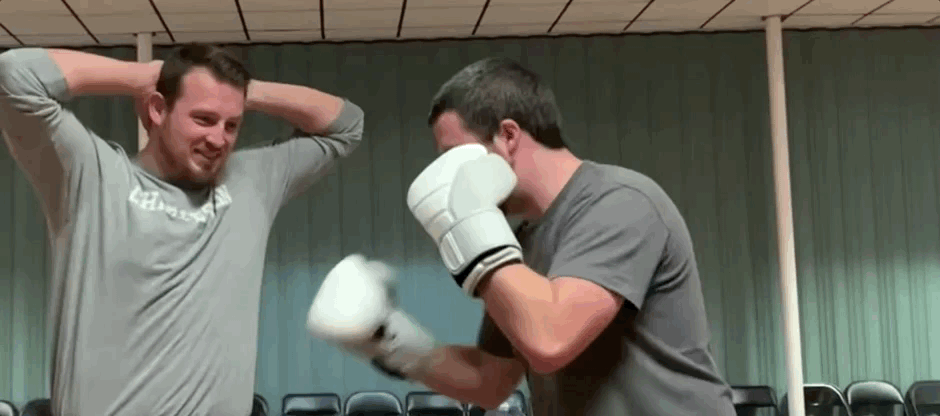
The doofus in the gray shirt, that’s me. Getting pieced up during a hard sparring session ahead of my amateur MMA debut three years ago.
Safe to say I left the gym that afternoon with a bruised ego and a dizzy spell. And I’m pretty sure I had a mild concussion, too.
If you’re reading this, you’ve likely been training a few months now and you already have a good grasp of the basics. You’re now thinking about doing your very first sparring session, and after hearing my little story, you’re probably freaking out.
If you are, please don’t. For one, hard sparring is a necessary evil for up-and-coming competitors who need to experience those requisite moments of adversity. It’s meant to get them battle-tested and not easily flustered once a right hook lands on their chin full clip.
But it doesn’t always have to be that way. Because especially for beginners, sparring can be a lot of fun.
It’s OK To Be A Spaz

When you think of sparring, the first three thoughts are probably along the lines of getting hurt, hurting somebody, and overall doing badly. Well, that all depends.
Generally, beginners end up hurting each other in sparring because of their inexperience. In their heads, it’s all about winning more than it is about learning. And that’s okay.
I remember my earlier months as a white belt in Brazilian Jiu-Jitsu and accidentally elbowing a purple belt in the nose. All because of my spazziness. As a thank you, he chose to cross-choke me until my eyes popped out within the next 30 seconds.
Everyone starts out as a white belt. At one point in their lives, the world champs in your gym were the raw talents that served as target practice for the more experienced guys. We’ve all been there.
But once you begin to do it more often and develop spatial awareness and correct body position, that’s when things become more enjoyable. And that’s when the learning begins.
If you’re still here, props to you. I’ll now share some of the sparring FAQs I get from beginners. These apply to the context of both striking and submission grappling.
When Should I Start Sparring?
In most Brazilian Jiu-Jitsu gyms, coaches will eventually allow you to spar around week two of consistent training sessions. In boxing gyms, they’d give about a month or two. Rightly so, because it involves hitting one another.
But if you ask me, it’ll be wise to get a good grasp of the fundamentals first before getting in there.
For the striking arts, it’s maintaining your stance and keeping your chin covered with both hands. For grappling, it’s knowing the correct way to fall and preventing yourself from getting flat on your back when fighting from the bottom position.
You will make A LOT of mistakes along the way, but that’s where firsthand learning comes into play.
What Gloves Should I Use For Sparring?

Let’s talk striking. In a previous piece, I mentioned that 14 or 16-ounce gloves work best for sparring. These gloves are heavier but provide more padding to avoid unwanted broken noses and concussions in the practice room.
But here’s the caveat: In no way do those hand pillows give you the license to whale on each other like you were fighting for a world title. Some people get this false sense of security behind the bigger gloves and they start hurting training partners.
Don’t be that person. Nobody wants to be the gym’s outcast.
How Can I Be A Good Sparring Partner?
This is always a refreshing question to hear. Whether it’s from a student or someone who’d just begun their training, I always admire these people for their desire to do things correctly right off the jump.
In martial arts, they say “you win or you learn.” If you’re at the beginner level, it should strictly be about the latter.
The real victory in the gym doesn’t come from landing a clean shot or tapping your training partner out. You know you’ve genuinely won if you can honestly tell yourself after every training session that you’ve learned something new.
A good sparring partner is someone who can give their peers that feeling of fulfillment from learning. They’re the ones you’d seek out from a crowd to do some rounds with because they give you that opportunity to try new things out.
If you’re that person, you’re doing it right.
How Do I Get Better At Sparring?

They say the devil is in the details. As coaches, we teach specific drills in class to help students absorb every bit of them a lot easier. It’s the same goal when you’re practicing the proper head position for wrestling or getting yourself used to lead with the jab in boxing.
As beginners, one of the best ways to get good at sparring is to apply these techniques.
We do expect you to resort to when sparring for the first time. That’s a given. But this will also allow you to see how these techniques work and eventually make the adjustments if needed.
So if today is left hook-cross-left leg kick day, try to incorporate that in your live drills. You’ll thank yourself later, I tell you.
What Are Your Best Beginner Sparring Tips?
I have a few good ones, I’m proud to say. These are based on some of my own mistakes and what I’ve seen others do.
Some of these you may already know and heard, but consider this as your little cheat sheet, nonetheless.
Be A Sponge
I was fortunate enough to have trained in some of the best gyms around the world. In 2017, I had the chance to attend a few of John Danaher’s classes at the Renzo Gracie Academy in New York City.
For the uninformed, John Danaher is a modern-day oracle. The man is a walking encyclopedia of techniques, dogmas, and philosophies of anything and everything grappling-related.
I chanced upon one of his star-studded submission grappling sessions one Saturday afternoon. The entire Death Squad was present: Garry Tonnon, Gordon Ryan, Georges St-Pierre. It was one hell of a party. A then relatively unknown Nicky Ryan turned me into a human ragdoll. Fun times.
I was already a blue belt at the time with three years of experience under my belt. But I stepped into those royal blue mats with a total beginner mindset. I thought to myself, ‘I paid $130 for this week, I have to make the most out of this.’
Now, of course, you can have other forms of motivation. But the point is, it pays to enter each sparring session as if it were your first day. Take in every bit of information you can get. ASK QUESTIONS.
And remember, anyone who’s had a significant enough amount of mat time will have something substantial to impart. Belt ranks don’t matter. Learn from everybody.
Leave Your Ego At The Door
You’ve likely heard this a thousand times over. Some gyms even have it written on their walls, in case you forget.
But I’m willing to bet the house that nine times out of ten, a sizable chunk of people don’t really take this to heart.
I’ve seen it happen countless times, mostly in boxing gyms. One guy enters the ring to spar, gets hit hard enough, and sees red. But instead of taking it in stride and smiling it off, he unloads with haymakers of his own.

Next thing you know, you have two inexperienced guys trading concussions with each other.
What did they get out of it? Other than a really bad headache for the next few hours, absolutely nothing.
Another quick story. Years ago, I used to always feel anxious right before jiu-jitsu class. I had almost zero talent as a white belt, and I knew that I’d take a good beating every session.
This went on through my early years as a blue belt. I’d have these apprehensions going into training, knowing that I’d easily get my ass handed to me by lower-ranked guys.
It wasn’t until my second year three years ago that I decided to embrace the fact that tapping out is inevitable in training. I’ve seen black belts tap out to blue belts in our gym. It’s part of the never-ending learning process of this beautiful art.
I think it would be much better to say, ‘Leave your ego in your bedroom.’ It does not have a place outside your home, let alone in society.
Save Your YouTube Techniques For Yourself
Want a sure-fire way to tick off your instructor? Ditch the techniques they’re teaching and instead use that little trick you learned on YouTube last night.
No, we don’t need to see how Eddie Bravo demonstrated the Twister, or how ‘Wonderboy’ Thompson taught his spinning back kick. These are well and good, but for a blank canvas like your beginner self, all of that’s useless.
Do yourself a favor and stick to the fundamentals. The ever-essential basics. You have to crawl before you walk and walk before you run or do backflips.
The fundamentals are the way to the light. These techniques will be your solid foundation for when you start learning the fancy-schmancy stuff.
Bonus: Beginner Sparring Drills To Try Out
I’m feeling extra generous today so I thought I’d add in a few sparring drills for you to try out. Now, I’ll assume you’ve been training for a while now and you’ve gained enough skills to speak the same language.
Yes, martial arts is a language in itself. Sparring is a way of communicating. You replace words with specific moves, and you react to them with your counters.
And since you’re beginners, we’ll focus more on going slow and playing off specific situations. Here’s what I mean.
Combo for Combo Sparring

Tit-for-tat sparring for some folks. This drill is all about practicing the combinations taught to you by your coach. And while the heavy bag is an effective tool on its own, that’s more for unleashing your power.
Combo for combo sparring makes you see what it’s like to land your combos on an actual human being. There’s less worry about getting bashed upside the head full clip because you’re both throwing at about 20 percent power.
This drill will sharpen your eye for finding those precious openings while getting yourself used to the feeling of getting hit. It’s also a fun and effective way to increase your fight IQ.
Slow Rolling

This is the grappling version of the tit-for-tat sparring. As beginners, you can’t expect to pick anything up in full-speed sparring. You’re getting your ass kicked, and that’s it.
Now, at this point, your techniques are pretty much shit. You don’t have the awareness or skill to mount any kind of offense yet. So how do you develop that? Again, by slowing things down.
Slow rolling allows you to have a deeper understanding of how the body moves during grappling. It’ll give you a better look at potential attacks at a given time while discovering counters to certain moves. Think of it like watching a video and putting it on slo-mo to decipher what’s happening.
I’d always tell my students to get at least five rounds of slow rolling per week. It’s a refreshing change-up from all the chaos during live sparring.
Sprawling Against Takedowns

One of the first instructions you’ll hear from your coach during wrestling class is to sprawl. If a training partner takes you down, your response should be to drive your hips down to the mat to stuff their shot and render their takedown attempt futile.
Easier said than done. Thankfully, the great Firas Zahabi is here to provide us with some pointers.
The drill starts off with both the defender’s hands on the attacker’s shoulders. This is to measure distance and to gauge where the opponent’s body is pointing towards. Because once you figure out the direction they’re headed, you’ll know which hip to drop.
In this case, the attacker is headed towards Firas’ right side. He responds by dropping his right hip to deflect the shot. The attacker now lost his leverage for the double-leg takedown and is even left in a more compromising position.
You can play around with this drill by having the defender get the back if he successfully stuffs the takedown. The attacker, meanwhile, should try and complete the takedown as much as possible. Reset the action once either one of these goals is achieved.
The Ultimate Beginner Sparring Tip
I actually have three tips that connect one general idea: Clear your mind. Take it easy. HAVE FUN.
The gym is that safe, controlled environment that allows you to be completely honest with yourself. It’ll give you a much-needed ego boost every time you achieve success, and it won’t judge you every time you fuck up.
Now go ahead and put yourself out there. Everything will be fine, I promise.




